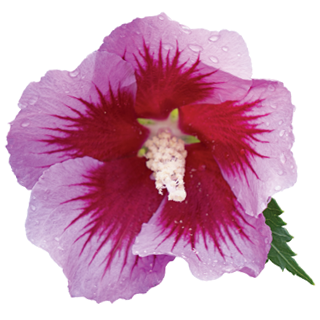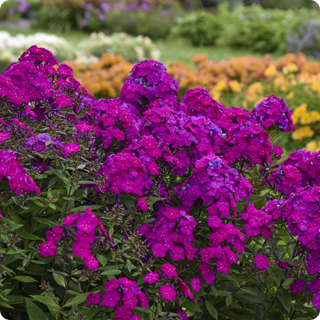PURPLE PILLAR®
HIBISCUS
Unique Space-Saving Rose of Sharon
- New shape, new uses!
- Rare, upright columnar habit
- Vibrant lavender purple, semi-double blossoms with a deep red center
- A favorite of pollinators and hummingbirds
- Blooms from midsummer into fall
- Heat and sun tolerant
- Grows to 10-16′ tall x 4-5’ wide
- Hardy in USDA Zones 5-9
Rose of Sharon has long been a beloved flowering shrub, but until now, people with small yards have had to enjoy this large, broad spreading plant from afar. Purple Pillar®, along with its red and white flowering siblings, have changed all that, making it possible for anyone with 4 to 5 feet of space to grow it. This columnar rose of Sharon will be the perfect fit in any sunny, narrow bed where you need some privacy or summer color.
Every year around midsummer, bright lavender purple, semi-double blossoms with a deep red center begin to pop open along its vertical stems. They easily attract the attention of pollinating bees, butterflies and hummingbirds which zero in on the flowers’ red eye, pollen-covered stamens and pistil. The color show keeps right on coming through fall. Deer may stop by to see what all the hubbub is about, but they usually don’t find this plant tasty.
how to grow purple pillar® hibiscus
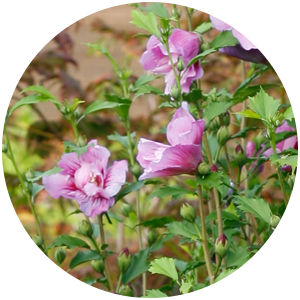
Planting
Rose of Sharon is easy to grow, even for beginners, and is undemanding once established. It can adapt to many types of soil as long as the drainage is decent, and will even grow under black walnut trees. Acidic and neutral pH soils are preferred.
Choose a spot that receives at least 6+ hours of direct sunlight each day. All-day sun will be welcome in the coldest zones where this plant is hardy. Though it will survive in some shade, it’s best to find a good sunny spot, stand back and watch it do what it does best—bloom prolifically and bring in the pollinators.
You’ll need to keep the plant watered the first year while it is getting its roots established, but then it should be able to withstand mild drought in subsequent seasons. Rose of Sharon thrives in heat and humidity.
In areas that experience heavy snowfall, avoid planting Purple Pillar where it might be dumped on by snow falling off of the roof or nearby evergreen trees since this can bend or break its long branches.
If you are planting Purple Pillar as a hedge and want the plants to grow together into one solid row, space them about 3 to 4 feet apart. For stand-alone specimens, give them six or more feet of room to mature. Keep in mind that this upright columnar shrub won’t take up much space as it shows off its personality by growing up rather than out.
When planting, dig the hole about twice as wide but just as deep as the container it is growing in. If the roots are densely circled around when you take the plant out of the pot, loosen them up a bit to break the “root memory”. This will encourage them to grow outward instead of continuing to grow in a circular pattern.
Set the plant in the hole, making sure that the top of the root ball is level with the top of the surrounding soil. Then backfill the hole soil. Press it down with your hands and feet firmly to eliminate any big air pockets around the roots.
Lastly, water the plant again to help the soil settle. Water deeply but less frequently to encourage deep, healthy roots. Deep trickle watering is best when establishing shrubs and trees the first growing season. Spread some mulch around the base of the plant, taking care to keep it from touching the base or trunk of the plant. The mulch will help to retain soil moisture, regulate soil temperature, suppress weed growth and protect the roots during winter.

Maintenance
Since Purple Pillar grows mostly vertical branches, it needs little to no pruning once it is established. However, in its first few years when the plant is still young, you can help it grow denser by trimming the tall stems down by as much as one-third each year until it has achieved the form you like. Early spring is the best time to prune rose of Sharon since it blooms on new wood.
After pruning in spring, apply a slow release shrub fertilizer like Espoma’s Rose-tone® by scratching it into the soil around the plant’s roots. Always follow package instructions for rates. Rose of Sharon likes to be fed each spring and will let you know if it is hungry by turning its leaves lighter green. No additional feeding should be necessary after spring.
Though rose of Sharon is fairly drought tolerant once established, you’ll know it is too dry if its foliage starts to wilt or it starts dropping flower buds. If you haven’t gotten much rain and don’t have irrigation, set your hose on a trickle at the base of the plant and let it rehydrate slowly and deeply. Mulching around the roots can help it survive drought better, too.
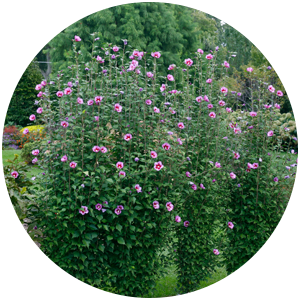
Uses
If you’re looking for a summertime screen for your deck or patio or want to create a backdrop for your perennial garden, this shrub would be a great choice. We’ve also found it useful for blocking the view of a noisy air conditioner. It’s less conventional than an evergreen hedge but just as upright and offers colorful blooms as a bonus.
To enjoy a single specimen of Purple Pillar, try setting one in the middle of a garden bed surrounded by shorter varieties of panicle hydrangeas, Upscale™ bee balm and Luminary™ tall garden phlox. Or plant a pair flanking an entry door or garden gate where its delightful blooms will greet you each day.
top 3 reasons to grow
purple pillar® hibiscus
SPACE-SAVING FORM
A narrow, columnar form makes this rose of Sharon easy to tuck into many spaces, even in small landscapes.
A BILLBOARD FOR POLLINATORS
This shrub’s bright, prolific blooms draw in all sorts of pollinating bees, butterflies and hummingbirds.
THRIVES IN HEAT AND HUMIDITY
When the going gets hot, Purple Pillar gets going! Watch it take off like gangbusters in the summer heat.
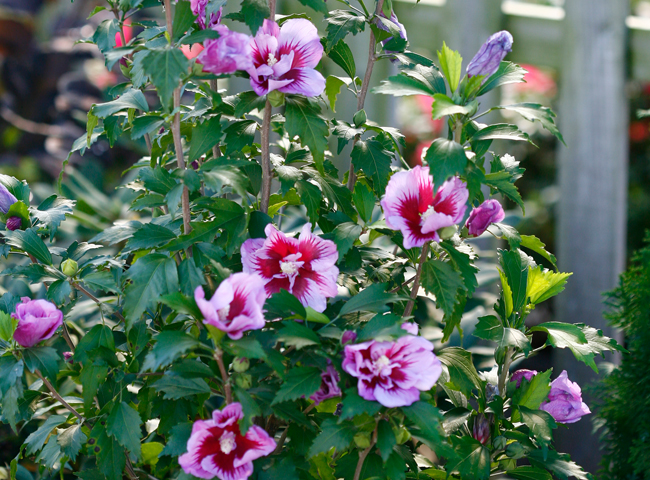
Purple Pillar® Hibiscus syriacus ‘Gandini Santiago’ USPP 25,568, Can 6,178

